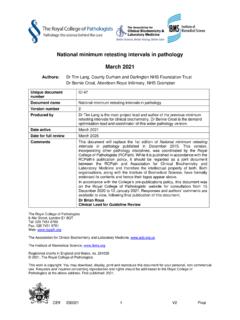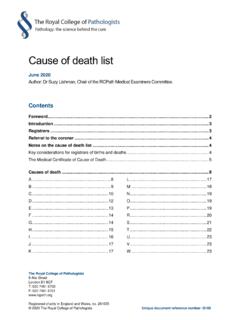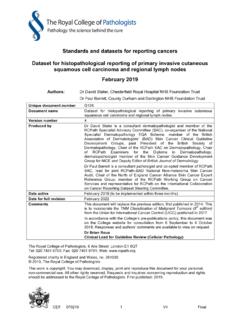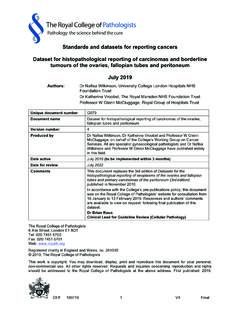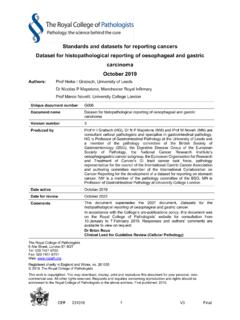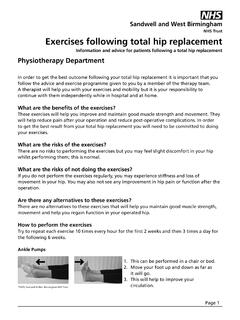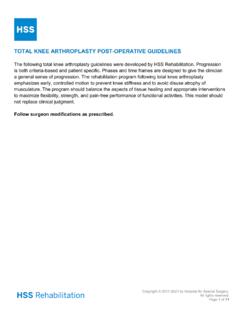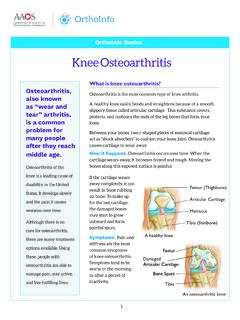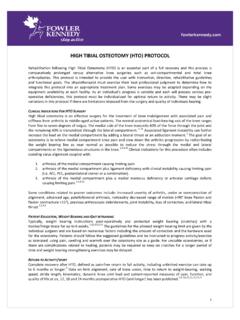Transcription of Part 1 Examination in Medical Microbiology and Virology ...
1 Part 1 examination in medical microbiology and Virology Sample MCQs Multiple Choice Questions Question 1 The cell wall of gram-positive bacteria may contribute to the development of septic shock. Identify the component which is most associated with the induction of septic shock. A Capsular protein B Endotoxin C Peptidoglycan D Phospholipid E Teichoic acid Question 2 Genetic variation in viruses contributes to their ability to evade the immuneresponse. Select the principal means by which antigenic shift occurs in influenza A virus. A Low fidelity of DNA dependent DNA polymerase B Low fidelity of RNA dependent RNA polymerase C Low fidelity of reverse transcriptase D Reassortment of fragments of the RNA genome E Recombination between RNA genomes Question 3 A 34 year old man with diabetic ketoacidosis develops headache, nasal congestion, periorbital swelling and a bloodstained nasal discharge.
2 Over a period of a week he become drowsy and unresponsive. ENT Examination shows black, necrotic lesions on the nasal septum, which is perforated. A lumbar puncture is performed but the CSF findings are entirely normal. Culture of the nasal discharge shows a heavy growth of Streptococcus pneumoniae and Staphylococcus aureus. Select the most likely diagnosis. A Dental abscess B Nasal diphtheria C Orbital cellulitis D Rhinocerebral mucormycosis E Severe maxillary sinusitis Question 4 The aminoglycosides are a very active group of antibacterial agents, particularly against Gram-negative bacilli. Identify their mode of action from the list. A Disruption of cytoplasmic membrane function B Inhibition of bacterial cell wall synthesis C Inhibition of bacterial DNA gyrase D Inhibition of protein synthesis E Interference with bacterial folic acid metabolism Question 5 A 22-year old female Medical student recently returned from Tanzania presents with a history of haematuria.
3 On investigation schistosomal serology is shown to be positive. Select the treatment of choice. A Albendazole B Ivermectin C Mebendazole D Praziquantel E Suramin Question 6 Many antiviral drugs act by inhibition of a viral DNA polymerase enzyme. Select the virus for which this class of drugs would be effective. A Cytomegalovirus B Influenza C Measles D Mumps E Rabies Question 7 You are informed of an outbreak of diarrhoea and vomiting amongst the 100 guests at a wedding reception. About two thirds of the guests became ill between 2 and 3 days after the reception. You obtain a list of guests and the menu for the buffet meal. Select the most appropriate epidemiological investigation. A A case-control study B A correlational study C A cross- sectional study D A randomized controlled trial E A retrospective cohort study Question 8 A 26 year old pregnant lady (17/40 gestation) consulted her general practitioner (GP) because her 2 year old son has a vesicular rash on his hands and in his mouth.
4 The mother is concerned about her unborn child. The GP is experienced and confident of his diagnosis of hand foot and mouth disease, but telephones you regarding further management. Choose the most appropriate advice. A Phone the local CCDC to find out if there is a current epidemic B Reassure the mother that there is no risk to the pregnancy C Refer the lady for fetal ultrasound scan D Send a vesicle fluid from the child for EM studies E Send blood for serological Examination Question 9 A mother takes her 6 year old son to her general practitioner (GP) extremely anxious because the child has that morning stabbed himself with a needle he found in a park frequented by drug users. Apart from a minor scratch to the right hand the child is otherwise well and has no past Medical history of note. Select the most appropriate action for the GP at this consultation. A Issue HIV post exposure prophylaxis to the child B Reassure the mother and suggest an accelerated course of Hepatitis B vaccine C Send the needle to the lab for testing D Suggest accelerated course of Hepatitis B vaccine and Hepatitis C immunization E Test the child for Hepatitis C, HIV, Hepatitis B surface antigen Question 10 A 5 year old boy is seen in the paediatric respiratory clinic for regular review of his cystic fibrosis.
5 He has a productive cough and a specimen is forwarded to the laboratory. Select the culture medium which would be most appropriate to isolate Haemophilus influenzae from this patient. A Blood agar B Chocolate bacitracin agar C MacConkey agar D Methicillin mannitol salt agar E XLD agar Question 11 You are asked to review the case of a 23 year old male student recently admitted with invasive meningococcal disease. He has made a good recovery but gives a history of a previous episode of meningococcal septicaemia when he was 15 years old. There is no history of other recurrent infections. Select the most likely immunodeficiency state. A Adenosine deaminase dificiency B C7 deficiency C Job s syndrome (hyperimmunoglobulinaemia E, defective chemotaxis) D Myeloperoxidase deficiency E Selective IgM deficiency Question 12 A 65 year old man has been commenced on standard quadruple therapy, including rifampicin, for suspected tuberculosis.
6 He has an extensive past Medical history and is taking an number of other medications. Select the drug which is most likely to have a clinically significant interaction with rifampicin. A Benzylpenicillin B Nonsteroidal antiinflammatory C Proton pump inhibitor D Thiazide diuretic E Warfarin Question 13 Blood donors in the United Kingdom are screened for evidence of infection with the organisms below. For most, the screening test is based on antibody detection and thus vulnerably to missing infections in the window period prior to seroconversion. The screening test universally used for one organism detects protein antigen and is thus less vulnerable to this problem. Select the organism for which this test is available. A Hepatitis B virus B Hepatitis C virus C Human immunodeficiency virus (HIV) D Human T-lymphotropic vius type 1 (HTLV1) E Treponema pallidum Question 14 A male baby is born at 39 weeks gestation with a petechial rash, low birthweight, hepatosplenomegaly and bilateral cataracts.
7 This is thought to be due to an infection acquired while the baby was still in utero. Select the condition which is most likely to cause this clinical presentation. A Cytomegalovirus B Group B streptococcus C Rubella virus D Toxoplasma gondii E Treponema pallidum Question 15 The complement fixation test (CFT) has largely been replaced by improved assays for evidence of infection. Select the organism for which CFT remains a useful laboratory diagnostic test of infection. A Coxiella burnetii B Cytomegalovirus C Herpes simplex virus D Neisseria gonorrhoeae E Parainfluenza type 3 Question 16 A 20-year-old woman presented with a 2-day history of fever, headache and confusion. On Examination , her temperature was C and her Glasgow coma score was 11. She had no neck stiffness or rash. Investigations: CT scan of brain normal cerebrospinal fluid: total protein g/L ( ) glucose mmol/L ( ) white cell count 126/ L ( 5) lymphocyte count 120/ L ( 3) neutrophil count 6/ L (0) What is the most likely causative organism?
8 A cytomegalovirus B enterovirus C herpes simplex virus type 1 D human herpes virus 8 E varicella zoster virus Question 17 A 12-year-old boy underwent appendicectomy for acute appendicitis. At the time of surgery there was evidence of localised peritonitis, and a pus swab was sent for culture. Which is the most likely pathogen? A Streptococcus agalactiae B Streptococcus anginosus C Streptococcus equi D Streptococcus gallolyticus E Streptococcus infantarius Question 18 A 23-year-old woman was referred with a 1-week history of fever, malaise, night sweats and painful joints. Two weeks previously she had had a sore throat. On Examination , her temperature was C, pulse 110 beats per minute, blood pressure 105/65 mmHg. She had a pan-systolic murmur, her chest was clear on auscultation. Her right wrist and left knee were hot, swollen and painful. Investigations: serum C-reactive protein 221 mg/L (<10) anti-streptolysin O titre 1600 echocardiogram evidence of pericardial effusion with mitral regurgitation Rheumatic fever is considered as a diagnosis Which of the modified Duckett Jones criteria are fulfilled to confirm the diagnosis?
9 A 1 major + 1 minor B 1 major + 2 minor C 2 major + 2 minor D 2 major + 3 minor E 3 major + 3 minor Question 19 A 72-year-old man developed fever and increased oxygen requirement while being ventilated 6 days after emergency surgery for a ruptured abdominal aortic aneurysm. Two days previously, he had been started on intravenous vancomycin for infection at the site of a peripheral intravenous cannula. He had a history of anaphylaxis following penicillin. On Examination , his temperature was C, his pulse was 98 beats per minute and regular, and his blood pressure was 124/78 mmHg. There was decreased air entry and coarse crackles were audible at the right lung base. Investigations: chest X-ray new infiltrate in right lower lung field What is the most appropriate addition to his antibiotic treatment? A ceftazidime B ciprofloxacin C co-trimoxazole D fosfomycin E tigecycline Question 20 A 24-year-old woman presented with a 2-day history of cough productive of green sputum.
10 On Examination , there were signs of consolidation at the left lung base. Her CURB-65 score was 1. She was attempting to conceive and was reluctant to take any antibiotic that might be harmful in pregnancy. Which antibiotic is most appropriate? A amoxicillin B azithromycin C doxycycline D levofloxacin E vancomycin Question 21 A 35-year-old woman presented with a 3-day history of productive cough, breathlessness and rigors. She was treated empirically with intravenous vancomycin. What is the site of action of vancomycin? A cell membrane integrity B DNA synthesis C peptidoglycan cross-linking D protein synthesis via the 50S ribosomal subunit E RNA synthesis Question 22 Four patients on an elderly care ward were diagnosed with norovirus infection. What immediate measure is most appropriate to prevent further spread within the institution? A close down the kitchen supplying meals to the ward B hydrogen peroxide vapour in affected areas C introduce alcohol hand rub to the ward D isolation of symptomatic patients E transfer asymptomatic patients to other wards Question 23 A 30-year-old man was diagnosed with acute hepatitis A virus infection.


